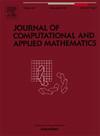A fast sequentially-decoupled matrix-decomposed algorithm for variable-order time-fractional optimal control and error estimate
IF 2.6
2区 数学
Q1 MATHEMATICS, APPLIED
Journal of Computational and Applied Mathematics
Pub Date : 2025-04-01
DOI:10.1016/j.cam.2025.116667
引用次数: 0
Abstract
We introduce a fast sequentially decoupled matrix-decomposed approach tailored for optimal control problems constrained by a Caputo time-fractional diffusion equation featuring hidden memory and space-dependent order. Our method unveils a quasi translation-invariant structure adept at managing spatio-temporal dependencies. This structure not only slashes the computational burden of coefficients from to , where and denote the spatial degrees of freedom and temporal steps in discretization, respectively, but also untangles the coupling between the space-dependent order and the inner product of the finite element method. Furthermore, we derive a swift matrix-decomposed algorithm designed to tackle the first-order optimality system, yielding a marked improvement in computational cost from to in each iteration. We substantiate our approach through rigorous numerical analysis and present numerical experiments to validate the theoretical underpinnings.
变阶时间分数阶最优控制与误差估计的快速顺序解耦矩阵分解算法
针对具有隐藏记忆和空间依赖阶数的Caputo时间分数扩散方程约束的最优控制问题,提出了一种快速的顺序解耦矩阵分解方法。我们的方法揭示了一个准平移不变结构,擅长于管理时空依赖性。这种结构不仅减少了系数从0 (MN2)到O(MNlnN)的计算负担,其中M和N分别表示离散化的空间自由度和时间阶数,而且解开了有限元方法中空间依赖阶数与内积之间的耦合。此外,我们推导了一种快速矩阵分解算法,用于处理一阶最优性系统,每次迭代的计算成本从O(MN2)显著提高到O(MNln3N)。我们通过严格的数值分析来证实我们的方法,并提出数值实验来验证理论基础。
本文章由计算机程序翻译,如有差异,请以英文原文为准。
求助全文
约1分钟内获得全文
求助全文
来源期刊
CiteScore
5.40
自引率
4.20%
发文量
437
审稿时长
3.0 months
期刊介绍:
The Journal of Computational and Applied Mathematics publishes original papers of high scientific value in all areas of computational and applied mathematics. The main interest of the Journal is in papers that describe and analyze new computational techniques for solving scientific or engineering problems. Also the improved analysis, including the effectiveness and applicability, of existing methods and algorithms is of importance. The computational efficiency (e.g. the convergence, stability, accuracy, ...) should be proved and illustrated by nontrivial numerical examples. Papers describing only variants of existing methods, without adding significant new computational properties are not of interest.
The audience consists of: applied mathematicians, numerical analysts, computational scientists and engineers.

 求助内容:
求助内容: 应助结果提醒方式:
应助结果提醒方式:


